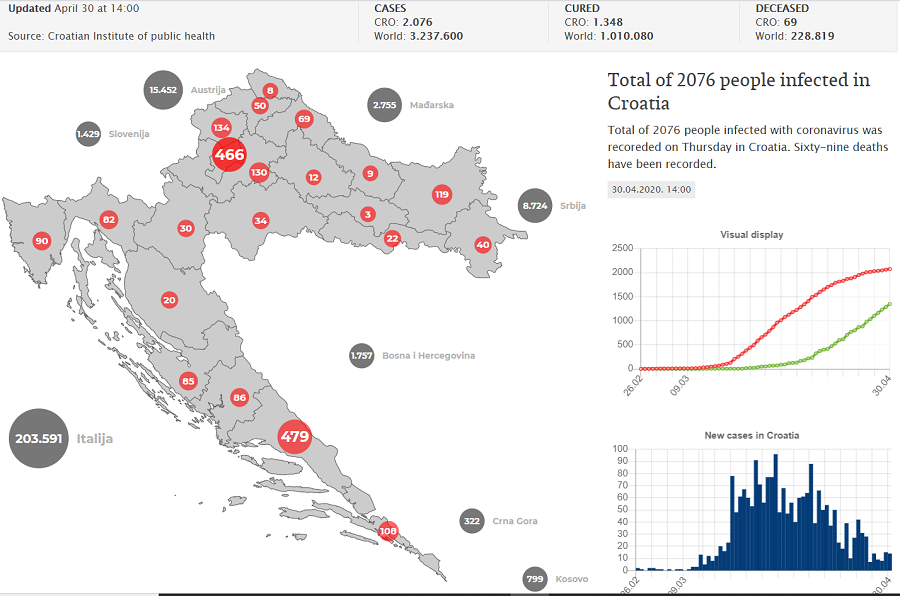Croatian Government Approves National Reform Programme: 3 Main Goals
As Poslovni Dnevnik writes on the 30th of April, 2020, on Thursday, the Croatian Government approved the National Reform Programme for 2020 and the convergence plan for both 2020 and 2021, which, in terms of economic policy, contains three key objectives - sustainable economic growth and development, linking education to the needs of the labour market and the sustainability of public finances.
To achieve these goals, 25 economic policy measures have been identified, grouped into 10 reform priorities.
These priorities are aimed at improving the business environment; future-oriented investment policy; improving the management of state property; improving public administration; improving the efficiency of the justice system; tweaking education and training in line with labour market needs; strengthening the framework for managing public finances and implementing fiscal consolidation; stimulating demographic revitalisation; improving the welfare system and ensuring the financial stability, sustainability and quality of the Croatian healthcare system.
The implementation of the measures is foreseen through 75 activities.
The programme also defines ten measures to achieve national targets under the Europe 2020 strategy in five different areas: employment, research and development, climate change and energy sustainability, education and the reduction of poverty and social exclusion.
Prime Minister Andrej Plenkovic said at the cabinet session that the programme was a reflection of the continuity of the Croatian Government's policy, but also a reflection of functioning in these new circumstances caused by the coronavirus pandemic.
Croatia's GDP is expected to fall by 9.4 percent.
The Croatian Government's convergence programme projects a GDP decline of 9.4 percent for this year and a recovery of 6.1 percent for next year. All components of Croatia's GDP, except government spending, will be slashed this year, said Finance Minister Zdravko Maric.
The general Croatian Government's budget is expected to record a deficit of 6.8 percent of GDP, or 24.8 billion kuna, in 2020, and in 2021, a general government budget deficit is projected to fall to 2.4 percent of GDP.
Based on the fiscal balance of the general government budget, public debt to GDP is expected to grow by 13.5 percentage points in 2020 when compared to 2019 and will amount to 86.7 percent of GDP, largely due to increased demand for borrowing due to the negative fiscal impact caused by the ongoing coronavirus pandemic.
In 2021, with the general government budget deficit narrowing to 2.4 percent of GDP and strong economic growth, public debt is expected to reach 83.2 percent of GDP, down by 3.5 percentage points when compared to 2020.
Consumer prices are projected to fall slightly in 2020, by 0.3 percent year-on-year.
The Croatian Government estimates that the introduction of the Croatian Employment Service's support for job retention will significantly reduce the impact of the negative shock on employment, with a 3.3 percent drop in employment expected throughout 2020, with an average unemployment rate of 9.5 percent in 2020, and of about 9 percent in 2021.
With respect to fiscal developments, direct budgetary aids are estimated at 14.9 billion kuna, which include the deferral of direct taxes and contributions, the write-off of direct taxes and contributions, the deferral of the 2019 annual income tax liability, aid when it comes to the maintaining of job positions and the procurement of medical and protective equipment to combat COVID-19, a price tag of 14.9 billion kuna has been estimated.
In addition, over 15 billion kuna was secured for favourable lending to entrepreneurs and businesses through HBOR and HAMAG BICRO programmes, and there is currently a 17 billion kuna moratorium on loans.
Croatia is much more prepared than it was back in 2008.
Minister Maric emphasised the fact that the main context of the adoption of the national reform programme for 2020 and the convergence plan for 2020 and 2021 are the devastating economic effects of the global coronavirus pandemic, but stressed that Croatia has dealt with the current crisis much more readily than it did when the global economic crisis of 2008 hit the country.
He recalled the fact that Croatia has had a surplus in its balance of payments account for several years, that its foreign debt was in a downward trajectory, and that it had achieved a budget surplus for three consecutive years, as well as a reduction in the share of public debt in GDP.
In addition, Croatia has introduced rapid and strong support to the private economic sector and achieved an enviable epidemiological picture, Maric added.
Make sure to follow our dedicated section for more on coronavirus in Croatia. For more on the domestic political scene, follow our politics page.
All Seven Music Festivals at The Garden Tisno Canceled in 2020
May 1, 2020 - Because of the current coronavirus pandemic, the festival season at The Garden Resort in Tisno is postponed until 2021, the organizers announced on Thursday, leaving Tisno without seven festivals at The Garden Resort this year.
HRTurizam reports that all seven events at The Garden Resort - Hospitality On The Beach, Love International, SunBeat, Outlook Origins, Defected Croatia, Dimensions and Dekmantel Selectors are delayed, with new dates already booked for next year, points out Nick Colgan, host of The Garden Resort in Tisno, and added:
"It is with very heavy hearts that we have to announce that all seven events at The Garden Resort in Tisno, are now postponed until the summer of 2021 due to the impact of the ongoing Coronavirus pandemic. Hospitality On The Beach, Love International, SunceBeat, Outlook Origins, Defected Croatia, Dimensions and Dekmantel Selectors all have new dates in place for next year.
We have all been monitoring the situation closely over the last few weeks, hoping that there was a chance for life to return to normal in July. However, it has become clear that local governments and international restrictions on travel and large gatherings will continue for some months to come, leaving us with no choice but to make this very difficult and heart-breaking decision. We take the health and safety of our community, staff and guests very seriously and we will follow the public health guidelines to fight against this worldwide pandemic.
Having worked closely with all the events in question we are very happy to be able to confirm the following dates and calendar for our 2021 season.
Hospitality On The Beach: 8th – 12th July 2021
Love International: 14th – 20th July 2021
Suncebeat: 22nd – 28th July 2021
Outlook Origins: 29th July – 2nd August 2021
Defected Croatia: 5th – 10th August 2021
Dimensions: 12th – 16th August 2021.
Dekmantel Selectors: 26th – 30th August 2021"
This year, festivals and events that bring together a large number of people will not be, both indoors and outdoors.
Loosening measures will not return life to the old ways, either - and it certainly will not mean that events bringing together a large number of people in one place - such as festivals, events, concerts, and sports events, can be organized.
If it is possible to organize them, in an optimistic scenario, it is a question of cost-effectiveness, because the question is how many visits will be made. Furthermore, when will the borders open, and who will travel at all?
Unfortunately, almost all festivals, events and congresses have been canceled or postponed this year, and those that are yet to be held are monitoring the situation day by day. However, it is not realistic to expect that any major events, i.e., large gatherings of people in one place, will be allowed this year, primarily for epidemiological reasons.
Interestingly, Ultra Europe (July 10-12) in Split and the Sea Star Festival (May 22-23) in Porec have not canceled yet, and ticket sales are still active.
The most recent decisions of the Croatian Government, which define epidemiological measures and restrictions to prevent and protect against the spread of COVID-19, imply a ban on public events and gatherings, without a clear date by which it will last. Also, the same announcements by other European governments on the ban on public gatherings in the coming months and on international travel bans are in force, which is why this decision was made.
To read more about lifestyle in Croatia, follow TCN's dedicated page.
Croatia Corona Travel, Tourism, Flights & Borders Update May 1, 2020
May 1, 2020 - So what is the latest Croatia corona travel advice? When will borders open, flights take off, and tourism finally begin? An overview of what we know at the moment.
Can you travel to Croatia? Around Croatia? Is Croatia safer than other destinations? When will tourism start? Who can cross the border?
With so many questions, so much uncertainty, and SO many people wanting to go on holiday and get tourism started, here is what we know today.
Croatia corona travel - how safe is Croatia and how well has it handled the corona crisis?
Croatia has handled the health threat from coronavirus extremely well, both in terms of measures taken and communication. The authorities reacted quicker than most as they watched the horror unfold across the Adriatic in Italy, and an extremely effective National Civil Protection Headquarters has kept infections and deaths well below the European average. And this despite the additional challenges brought on by the Zagreb earthquakes.
Croatia currently has 2,076 cases of infection, which has resulted in 69 deaths. The majority of cases - 1,348 - have recovered.
The authorities also moved quickly not only to close borders, but also to localise infection by severely restricting all unnecessary travel between municipalities. Its famous tourist islands have remained almost totally corona-free. Only those with an island ID were permitted to use the ferries, and only then with a special purpose.
So in terms of its approach to the virus, and the results, there is perhaps nowhere better than Croatia.
And then question on everyone's lips is - when can we travel to Croatia, and is Croatia corona travel safe?
Nothing is totally safe in these very uncertain times, but I would say that COMPARITAVELY speaking, Croatia is as safe as anywhere in Europe to come for a holiday IF conditions allow. More on that below.
What is the current situation with Croatia's borders? Who can enter the country?
- at Bregana and Macelj (with Slovenia);
- at Goričan and Duboševica (with Hungary);
- at Nova Sela, Stara Gradiška and Slavonski Šamac (with Bosnia and Herzegovina);
- at Bajakovo (with Serbia).
- use motorways only;
- use the following rest areas only: Novska jug, Novska sjever, Kozjak jug, Prokljan sjever, Draganić sjever, Draganić jug, Bačva, Ravna Gora, Lužani in direction Lipovac and Staro Petrovo Selo in direction Bregana;
- during breaks keep distance between You and other people;
- obey the rules of Civil protection or police officers.
- at Goričan border crossing, detour: Goričan junction-ŽC2026-DC3;
- at Dvor and Vitaljina border crossings - open only to passenger traffic;
- at Gunja border crossing - there is a traffic ban on freight vehicles and buses.
Due to traffic bans on freight vehicles in Slovenia long delays should be expected in freight traffic at Bregana/Obrežje and Macelj/Gruškovje border crossings starting 1 June.
What is the latest news about the borders opening for tourism?
Everyone WANTS tourism to begin, but just how safe is it, when might it happen, and will it be for everyone?
Some clues from some recent TCN articles:
Gari Cappelli and Slovenia Optimistic about Opening Borders between Two Countries (April 30)
EU Ministers Meet: COVID-19 Passport, Cro Card and More (April 28)
Istria County Tourism Committee Hosts First Session about Opening Borders (April 28)
COVID-19 in Croatia: Gari Cappelli Discusses Summer Travel with EU Tourism Ministers (April 28)
Austrian Media: Croatia is Our Best Chance for Summer Holiday (April 27)
German Bild on Croatia: Corona-Free Destination for Summer Travel (April 25)
What about flights to Croatia? An overview of all the major airlines to Croatia and their current positions
If there is one tiny cloud with silver lining for Croatian tourism, it is that the vast majority of its visitors arrive by car. The proximity of countries such as Slovenia, Austria, Germany, Poland, Czechia, Slovakia, Hungary and Serbia mean that the season will not be a total disaster if it is allowed to start. Holiday options for these countries will be more limited due to the drastic reduction in flights which will be a post-corona reality. So destinations such as Greece, Turkey and Egypt will be much harder to reach than hopping in a car from Central or Eastern Europe.
The big intercontinental carriers have mostly writtten off 2020 totally, with Qatar Airways and American Airlines, delaying Dubrovnik until 2021. And with the CEO of easyJet saying the airline will feel like a new startup post-corona, Ryanair's homepage focusing on September breaks since March, and Norwegian Air on the brink, the reality is that flights to Croatia will be much reduced. The official Koronavirus website has produced this very helpful overview of where individual airlines are with their plans. You can follow the updated page here.
CROATIA
From May 11, Croatia Airlines will operate flights on the following routes within Croatia:
Zagreb - Split
OU652 (08:00 - 09:00)
OU656 (20:20 - 21:10)
Split - Zagreb
OU653 (09:45 - 10:35)
OU657 (21:50 - 22:40)
Zagreb - Dubrovnik
OU662 (08:00 - 09:05)
OU664 (20:20 - 21:25)
Dubrovnik - Zagreb
OU663 (09:50 - 10:55)
OU665 (22:10 - 23:15)
Information on other domestic flights will be published later.
Dubrovnik Airport is closed to civilian traffic until 02/05/2020. due to preventive measures to prevent the spread of coronaviruses. More details.
Osijek Airport - from 27.4. the Pothodnik branch reopens. While prevention measures are in place, the opening hours will be 9 am-5pm on weekdays (Monday through Friday). More information can be obtained by e-mail This email address is being protected from spambots. You need JavaScript enabled to view it. and phone +38531284611. It is recommended that all inquiries be sent in writing to the specified e-mail. More information.
The Croatia Airlines contact center is available on the following numbers: 0800 77 77 (toll free calls from Croatia), 072 500 505 or +385 1 66 76 555. More info.
AirBaltic - All AirBaltic connections are suspended from March 17 to May 12, 2020, including airBaltic operations from Estonia and Lithuania. Click for the latest info.
Air France - Due to coronavirus, they have reduced 90% of flight capacity and this supply reduction is in effect until the end of May. Due to the closure of Paris-Orly Airport, all flights from and to Paris go via Paris-Charles de Gaulle Airport. Latest info.
Air Canada has suspended all flights between Toronto and Zagreb for the summer of 2020.
Austrian Airlines, a branch of Lufthansa, has decided to suspend all its scheduled flights until 3 May 2020. More details.
British Airways - the latest updates.
Brussels Airlines has decided to suspend flights until May 15, 2020. More details.
Czech Airlines has suspended flights to / from Prague from 16 March, as a result of the Czech government's declaration of a state of emergency and a related ban on foreigners entering the Czech Republic. More details.
easyJet - They made the decision to ground the aircraft until further notice. More details.
Emirates - Emirates has established limited passenger flights to transport passengers departing from the UAE. More details.
Germanwings - Germanwings flights no longer exist.
KLM - Latest info.
Lufthansa - More details.
Ryanair - As most EU countries have imposed flight bans or other restrictions, more than 90% of Ryanair's aircraft are grounded, and the limited flight schedule has been extended until 14 May. More details.
Turkish Airlines - All international flights are canceled until May 28, 2020. More details.
Qatar Airways - all direct flights between Zagreb and Doha are suspended until May 31, 2020. Flexible when changing travel plans until September 30, 2020. For more information, contact the Qatar Airways office in Zagreb at +385 (0) 1 4961110 / 111, email: This email address is being protected from spambots. You need JavaScript enabled to view it. or check the details here.
Wizz Air - In early May, it will fly from Budapest to Athens, Barcelona, Berlin, Birmingham, Basel, Dortmund, Eindhoven, Gothenburg, London, Liverpool, Madrid, Podgorica, Sarajevo, Stockholm and Targa Mures. See more here.
What about freedom of movement within Croatia at the moment?
After weeks of being confined to the individual municipality, restrictions were recently lifted on travel within Croatia's 20 regions (but not in all cases). It is expected that this will be loosened further if the current situation remains stable - from May 11. Please note that countywide travel is not the case everywhere - for the latest, check the official government Koronavirus website.
The authorities announced yesterday that those with real estate elsewhere in Croatia can now get a permit to visit it - good news for the many people with holiday homes on the coast.
New measures are due to come into effect on May 4 - what are they?
On April 23, 2020, Prime Minister Plenkovic announced his 3-phase plan to loosen restrictions.
Part one has already come into force:
PHASE 1 - April 27, 2020
- Ability to work for all business entities engaged in trade, except those operating within shopping centers
- Continuation of work to all business entities engaged in service activities, except those in which close contact with customers is observed, respecting physical distance measures (for example, carpenter, tailor, locksmith, travel agencies, photo studio)
- Introduction of public city and suburban transport lines and express lines for islands not connected by ferry
- Libraries, museums, galleries, antiques and bookstores to open
- Facilitating training of athletes I and II. categories in individual sports and senior sports teams competing in the highest level of competition
- Facilitating the state professional exam for priority groups of students
And the second phase is due to come into effect on Monday:
PHASE 2 - May 4, 2020
- Enabling the full operation of the public health system, with the exception of exceptions in line with the Ministry of Health measures
- Enabling the full operation of the private health system, with due regard for specific epidemiological measures
- Ability to work for all business entities engaged in service activities in which close contact with clients is observed, with respect to specific epidemiological measures (for example, hairdressers, beauticians, barbers, pedicurists)
Additional measures are due to come into effect on May 11 - what are they?
PHASE 3 - May 11, 2020
- Gatherings of up to 10 people in one place allowed, while respecting physical distance measures
- Facilitating the operation of shopping malls while respecting specific epidemiological measures
- Facilitating the work of preschools and elementary classes from grades 1-4 and special classes and working with children with disabilities who have a teaching assistant
- Laboratory, artistic and clinical exercises and practical work allowed in small groups in higher education
- Introduction of inter-county and domestic air services
- Allowing catering facilities to work exclusively in outdoor areas and terraces
- Allowing catering facilities to work in accommodation facilities only for users of accommodation services
- Operation of national and nature parks allowed
- Expanding opportunities for issuing e-passes
What is the situation with ferries in Croatia?
Currently, only people with a special permit are allowed to travel on the ferries in Croatia.
A reduced service is running - here is the timetable in full in English, valid until May 28.
Starting on Sunday, 26 April, the Zadar-Ancona international ferry resumed for freight vehicles only.
TCN reports from the ferry terminal in Stari Grad on Hvar to give an indication what current ferry traffic is like.
You can check the latest news in English on the Jadrolinija website.
Are buses running between cities in Croatia?
Currently no.
What about local transport?
Some local transport has now restarted.
An overview of the situation in Zagreb.
Are there any trains currently running in Croatia?
Currently no.
What is the situation on Croatia's roads and motorways?
There is obviously a lot less traffic on the roads currently. For the latest information on roadworks and other problems, check this HAK page (in English)
Are taxis and private transfers available in Croatia?
Yes. I checked with one of the most reliable providers, Octopus Transfers, and they are able to cover transfers all over the country.
What are the self-isolation rules for people entering Croatia currently?
People entering Croatia are required to self-isolate for 14 days.
Will Ultra Europe 2020 take place in Split, and what about other festivals?
We are getting a LOT of emails asking whether or not Ultra Europe will take place in July. Tickets are being sold on the Internet, which gives festival-goers hope. This is the latest we have.
The situation is constantly evolving, and for the latest on travel updates and all other coronavirus developments, we recommend you follow the dedicated TCN COVID-19 section.
If there are errors or omissions in the above, please contact me at This email address is being protected from spambots. You need JavaScript enabled to view it. Subject Travel Update, so that I can get this resource updated. Thanks in advance and stay safe.
Analysis: Coronavirus in Croatia Compared to Other European Countries — April 27 Update
April 30, 2020 — A graph showing the number of deaths from or with the SARS-CoV-2 virus per million of the population places Croatia among the five best-ranked countries with the lowest proportional death toll, according to the Johns Hopkins University Coronavirus Database.
In addition to Croatia, there are Greece, Poland, Bulgaria, and - according to the available data - Slovakia. The next low-mortality group includes the Czech Republic, Hungary, Finland, Romania, Estonia, Norway, and Slovenia, with the worst situation affecting Belgium, Spain, Italy, and France. Sweden has around 16 times the death toll per million inhabitants compared to Croatia, a comparison mentioned often due to its lack of measures.
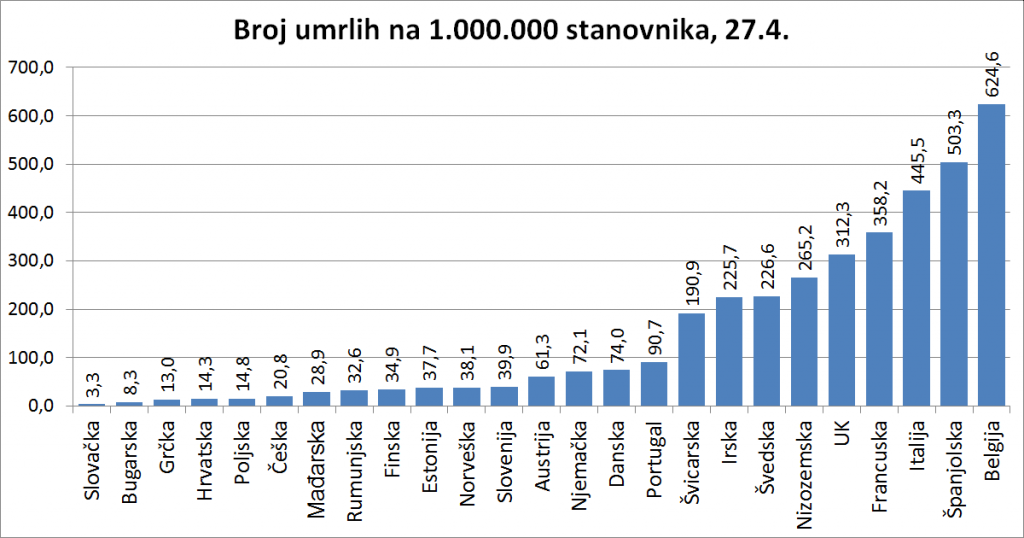
Specifying only the absolute numbers of registered infected persons or persons who died from or with the presence of COVID-19 per country does not give a true picture of the situation, given that there are huge differences in the population of individual states. In this way, for example, the terrible situation in Belgium, with its 11.5 million inhabitants in absolute numbers (7,207), has seemingly far fewer casualties than, for example, Italy with its 60,5 million inhabitants (26,977) for a long time.
It can also be said that Germany, with 6,021 deaths, has far more casualties than 2,274 in Sweden, which is not really the case at all. On the contrary, Germany with 83.5 million inhabitants is significantly more successful in fighting the epidemic so far than Sweden with 10 million inhabitants.
Likewise, it is difficult to compare the development of an epidemic by country in parallel if one looks at the number of registered infected persons on the same date, regardless of the outbreak of the epidemic in each country. The following figure shows the movement of the number of registered patients in several European countries on the same dates.
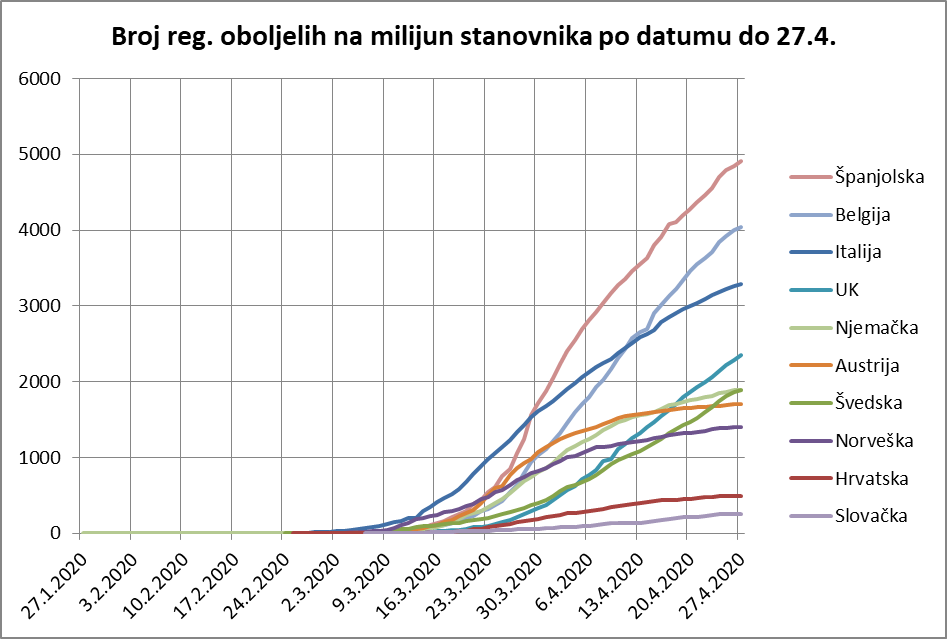
The graph shows a comparison of the currently registered sick per million inhabitants, but it is even more important to note the slopes of each curve in the last week or 14 days. The slope speaks to the rate of spread of the epidemic, of course, as much as there are registered patients.
We do not know the number of unregistered infected persons. It can be seen that Slovakia and Croatia have excellent control over the epidemic; that Norway, Austria, and even Germany have successfully reconciled the earlier spread of the infection, that Italy is slowing down its situation. Spain is having more difficulties, that Belgium and the UK are in a linear curve phase, and it seems that Sweden also achieved a linear curve, although it "overtook" Norway and Austria and "overtook" Germany.
However, here we also provide an overview that begins for each country from the date the first infected person was registered. In this way, it is possible to compare the development and effects of epidemic suppression both in dynamics and in relative numbers per million inhabitants.
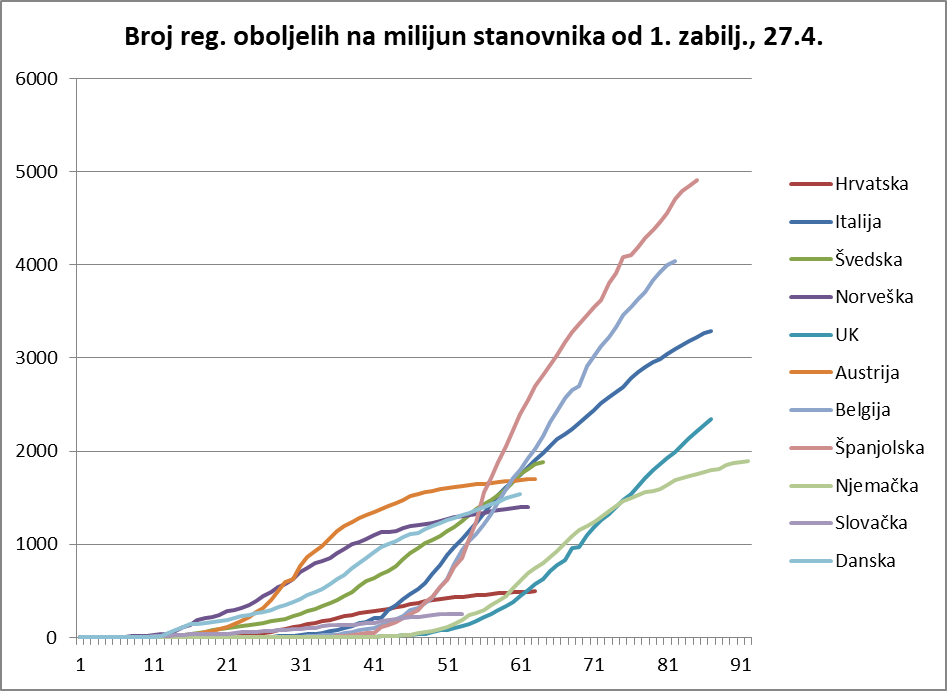
This chart does not show all the countries that are in the first, not only because such a view would become completely opaque, but also because of the abundance of data that needs to be monitored.
At first glance, two groups stand out. The left group is one in which the epidemic developed relatively quickly after the first registered infected person in terms of population: Austria, Norway, Denmark, Sweden, Croatia, and Slovakia. Of course, these are smaller countries. The right group is one in which more time has elapsed since the first registration of the infected person, and these are countries with a larger population.
In the first group, there was a rapid increase in the number of people infected in Austria, but also a very rapid response that reversed the epidemic as early as the 32nd day, and even without "leveling", a consistent reduction in the number of new patients was immediately achieved. The epidemic has calmed down after about 50 days in that country, which of course has a great impact on deciding what to do next.
The epidemic in Norway, with an even sharper start, had a similar course, but apparently by the rapid reaction of the authorities, who reversed the trend around the 32nd day as well and achieved a calming around the 45th day.
In Denmark, the epidemic started very much like in Norway, with the first leveling off happening faster, but with more rapid growth again. Currently, the curve is linear.
The same group is followed by Sweden, which initially did not have rapid growth but, by the 55th day, has grown in the number of registered infected persons Denmark, Norway, and Austria, and there is no sign of the infection slowing.
Viewed in this chart, Croatia and Slovakia are maintaining a linear curve almost from the start of their epidemics. They maintain a very low slope linear curve and have the lowest number of registered infected persons per million inhabitants.
The group of larger countries shows that the worst situation is in Spain, which after exponential growth until the 56th day of the epidemic in its territory and then from around the 62nd day a slightly milder but still large slope with no indication that the epidemic would soon begin to subside.
It is similar in Belgium, which straightened the curve around the 54th day but has since maintained a steady but high (relative) increase in newborns with no indication of calm.
Italy, whose exponential curve started about a week before the one in Spain, reached a more moderate slope of the linear part of the curve around day 49 and shows a slight calming of the epidemic.
Germany, with some time lag compared to the first registered infected person, achieved a curve similar to Austria, with a trend reversal around day 68.
After exponential growth, the UK was able to straighten the curve around day 70, but with no indication of calm.
Looking closer to Sweden, we can see a form of exponential growth in the number of infected.
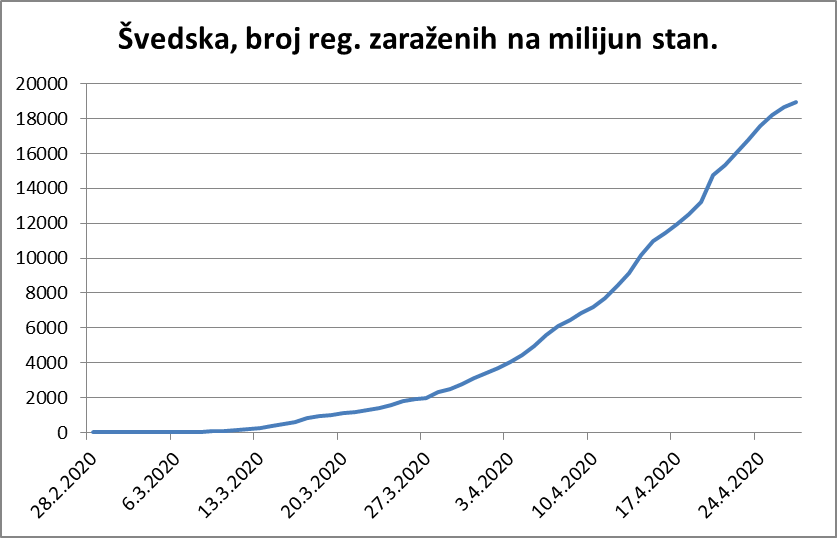
If we take a closer look at Croatia, we will see that linear growth has already been achieved around March 22 (just after the earthquake in Zagreb), that an even better slope was achieved after April 1, and that from April 16 we can speak of a calming epidemic.
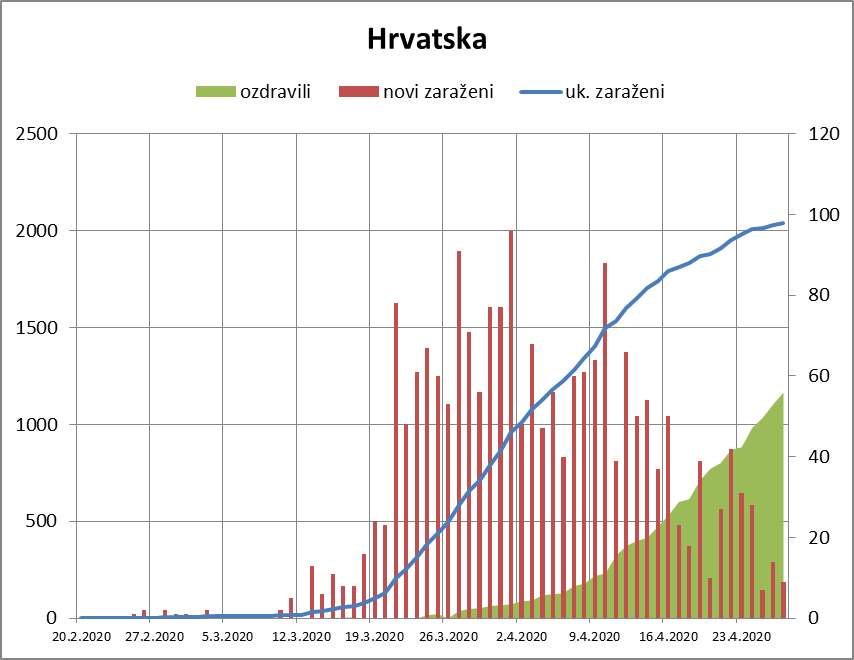
Croatia's excellent result can also be seen in the chart showing the trend in the number of sick and dead.
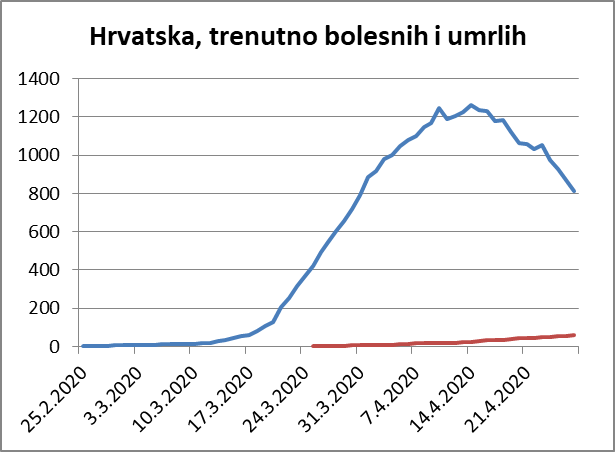
These topics often raise the question of what is a good test measure and whether we are testing enough. An excellent graphical representation of the testing ratio per million population and the percentage of positives shows who optimally tests and who does not. If you are about 10% positive you have found a good measure - Croatia is. Something ugly is coming to Brazil, only if the good weather saves them.
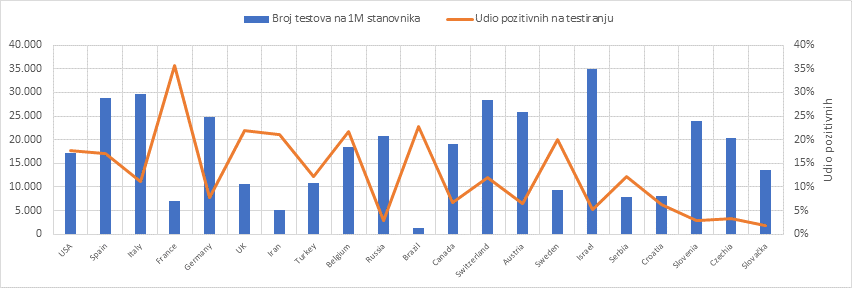
From everything I think it can be concluded how useful it is when policies are established on the basis of scientific knowledge and data. Scientific knowledge, in comparison to the usual political ones, is neither conservative nor radical; they are simply as they are and should be trusted. But these lessons are not exclusively health, but equally political, especially when we talk about loosening up on measures.
Of course, every state can be asked what its long-term prospect is in these new circumstances. That will not go away. Some countries, which have curbed the epidemic in the sense that they have ensured that their health care system can control the situation, maybe far more comfortable developing a further strategy than those who still have to put all their efforts into maintaining the health system's functionality.
And finally - is coronavirus more dangerous than the flu? Yes, but as far as we may know, in just a few months, we learn something new every day. The important difference is that we do not have vaccines and that the virus can mutate more often in a large number of patients.
Find more good visualizations of a pandemic at Croatia Mireo and Velebit.ai.
GDP to Shrink by 9.4% in 2020, Rebound by 6.1% in 2021
ZAGREB, April 30, 2020 - The government forecasts that this year Gross Domestic Product (GDP) will fall by 9.4% while in 2021, recovery is expected at a rate of 6.1%.
The government session on Thursday discussed the 2020 National Reform Programme and the Croatia's Convergence Programme for 2020 and 2021.
The convergence programme projects the contraction of the national economy by 9.4% in 2020 while in 2021 the government expects a recovery and growth rate of 6.1%.
Opening the cabinet meeting on Thursday, Prime Minister Andrej Plenković said that with reference to economic policies the National Reform Programme rests on three existing objectives that the government had set at the outset of its term.
That is sustainable growth and development, connecting education with the labour market and the sustainability of public finances.
Under a baseline scenario, the main adverse impact on the domestic, and global economy will be of a short-term nature.
It is expected that the general government budget will record a deficit of 6.8% of GDP or HRK 24.8 billion in 2020 while in 2021 the general government budget deficit is expected to be reduced to 2.4% of GDP, he said.
The public debt to GDP ratio in 2020 is expected to grow by 13.5 percentage points compared to 2019 and will amount to 86.7% of GDP, mostly due to increased needs for borrowing as a consequence of the negative fiscal effects caused by the coronavirus pandemic.
In 2021, subsequent to reducing the general government budget deficit to 2.4% of GDP and strong economic growth it is expected that the public debt to GDP ratio will fall to 83.2% of GDP, which is a drop of 3.5 percentage points compared to 2020.
Consumer prices are expected to drop mildly in 2020 by 0.3% year on year.
The government is counting on job-keeping measures to buffer the shock on the unemployment rate and that the fall in the number of people employed will drop by 3.3% in all of 2020, and the average surveyed unemployment rate in 2020 will amount to 9.5% and 9% in 2021.
As far as fiscal trends are concerned, direct aid from the budget is estimated at HRK 14.9 billion which includes deferments on taxation and contributions, writing-off direct taxes and contributions, deferring profit tax for 2019, job-keeping incentives and the procurement of medical protective equipment in the fight against COVID-19.
An additional HRK 15 billion has been secured for favourable loans for entrepreneurs under schemes provided by the development bank HBOR and and the HAMAG BICRO agency, as well as HRK 17 billion for a moratorium on loans.
More news about GDP growth can be found in the Business section.
Orepić Joins HSS; Party Might Run in Election on Its Own
ZAGREB, April 30, 2020 - Croatian Peasant Party (HSS) leader Krešo Beljak confirmed on Thursday that MP Vlaho Orepić had joined the HSS, stressing that the party was not ruling out the idea of running in the parliamentary election on its own.
The HSS is seriously preparing for the election, whenever it may be, and it is ready to compete in any configuration, Beljak said, confirming that he was in talks with the Social Democratic Party (SDP) and other opposition parties on running together in the election but was not ruling out the possibility of the HSS running on its own.
He recalled that he had been pushing for opposition parties with similar platforms to come together but that the outcome of talks was not just up to him.
"We are ready for an agreement, not just with the SDP but with other opposition parties as well, but that does not mean that the HSS will wait around or beg anyone," he said.
He recalled that for two years the party had been advocating its New Republic platform, which, he said, defined what Croatia needed, and he believed the current crisis provided an opportunity to implement that platform.
Beljak described Orepić's joining the HSS as a great addition, announcing that his New Politics party would join the HSS.
Orepić, who is a former member and founder of the MOST party and now leads the New Politics party, said that the HSS is a "progressive, republican and green" party and that its platform covers the broad policy of the centre that was promoted by his party.
The New Politics' main aim is to protect Croatia as an environment and that ideological contribution would be built into the HSS, said Orepić, adding that the Opposition should unite in the fight against policies that had robbed and divided Croatians, forcing them to emigrate.
Orepić said he was not afraid that voters would think he was a turncoat because, as he said, his political positions were the same as on the first day of his political career.
MOST has turned into a far-right party and that is why I left it, he said.
More HSS news can be found in the Politics section.
Consumption in March Decreases by 7%, Biggest Drop since 2010
ZAGREB, April 30, 2020 - Consumption in Croatia in March dropped 7% from the same month of 2019, which is its biggest decline since 2010, when the economy was in a recession.
The national statistical office (DZS) on Thursday published a report on retail sales and according to working-day adjusted data, consumption in March dropped 11.7% from the previous month and by 7% in relation to March 2019.
This is a sudden change in trends considering that in February retail trade grew by 4.9% on the year.
The steep decline in consumption is due to restrictions imposed to prevent the spread of the coronavirus, which took effect in the second half of March.
A decline in retail trade of 7% had not been recorded since January 2010, when the economy was in a recession.
More economic news can be found in the Business section.
Industrial Output Down Close to 5%
ZAGREB, April 30, 2020 - Industrial production in Croatia in March 2020 dropped for the fifth consecutive month, sliding by 4.9% from the same month of 2019, and much faster than the month before.
According to figures from the national statistical office, industrial output in March dropped by 2.8% from the previous month, while in relation to March 2019 it went down by 4.9%.
March was the fifth consecutive month to see a year-on-year decrease in industrial output, with the decline picking up in March as the month before industrial output dropped by 2.1%.
The production of durable consumer goods dropped the most year on year, by 23.5%, followed by the production of capital products, which decreased by 14.8%.
Only energy production saw an annual increase, of 9.8%.
In the first three months of this year, industrial output dropped by 4.2% in relation to the same period of 2019.
Since the Croatian economy is largely connected with the European economy, the strong contraction of economic activity in the EU will spill over to the national economy, analysts of Raiffeisenbank Austria (RBA) said.
The EU's statistical office Eurostat said on Thursday that the EU's GDP in Q1 had dropped by 2.7% from the same period of 2019 due to the coronavirus crisis, which is its greatest decline since the global financial crisis of 2009.
The RBA analysts said that trends in industrial production would depend on the success of the fight against the coronavirus pandemic and the duration of restrictions on economic activity, which would slow down recovery.
After a modest growth rate of 0.5% in 2019, industrial output in 2020 could see a double-digit drop, the analysts said.
More economic news can be found in the Business section.
Doug Lansky: How Coronavirus Will Force Destinations to Stop Overtourism
April 30, 2020 - How will the coronavirus affect one of the scourges of travel in the last few years - overtourism? Acclaimed tourism guru Doug Lansky on a must-watch video for Croatia's tourism chiefs.
Does anyone remember the word 'overtourism'? From memory, it entered the mainstream English language a few years ago, as a way to define the issue of too many tourists in one place at one time.
And it was only a few months ago.
And until just a few months ago, Croatia's tourism strategy seemed to be focused on numbers, numbers, numbers. Insane growth in a short time saw private accommodation beds double from 400,000 to 800,000 in just a few years, lured by great tax incentives. So good in fact, that many people took advantage of them, paid almost no tax on the earnings, and then made enough in 4-5 months so that they did not have to work for the rest of the year.
Things have changed with corona. A lot. And while the health risks and economic downtown will be extremely painful, so too does corona give us the chance to reassess our lives and our priorities.
And our tourism.
I met Doug Lansky at the Crikvenica International Heath Tourism conference in Selce last year, where I - along with everyone else in the room - was extremely impressed with his excellent keynote speech, Successful Tourism.
So impressive in fact, that Lansky was hired for two more keynote spots planned for earlier this year, EPIC 2020 in Dubrovnik and One Day or Day One #hrturizam2030 in Zagreb. Both have been postponed due to COVID-19.
He may not be travelling, but Lansky is still very active, and recently posted this outstanding overview on tourism, overtourism and the corona effect. It is a must-watch for tourism planners, and I hope our tourism chiefs find the time. For we need another strategy beyond numbers, numbers, numbers.
Destinations have been wrestling with overtourism issues for years. What's been lacking is a fundamental understanding of the forces behind it, what early-stages of overtourism look like, and the political will to take the necessary steps to solve the problem. This video explains the key underpinnings of overtourism (aka congestion/ overcrowding / unbalanced tourism) and shows how the Coronavirus [COVID-19, SARS-CoV-2] provides an opportunity for destinations to make long-overdue smart and sustainable tourism decisions. Doug Lansky is a keynote speaker and advisor in the tourism industry. Find his TEDx Talks and more info at www.douglansky.com
Among the initial comments:
Very good. I run a yacht in Montenegro and no longer go from Kotor as it's a cruise ship stop and fifty speedboats have appeared in two years to race guests up and down the bay as fast and cheaply as possible. We don't even go near the place as the normally still, beautiful water at the end of the bay looks like open sea due to the washes. We saw this happen in Dubrovnik first and so adapted our itinerary and marketing, so the proposals in this film really resonated.
For more on Croatian tourism, visit the TCN travel section.
Music and Friends - Nostalgia for Dubrovnik in the Coronavirus Age
April the 30th, 2020 - Coronavirus. Isolation. Social distancing. Missed hugs. Missing people, at least one coffee with friends. From the bed to the kitchen and back is the typical distance made these days. The world is going virtual. All other things we are living through in these so deeply and radically different times.
The e-mail was quite short and adamant. It began with: ‘I told you that you would sing in public again”. (What?). It included, all quite dryly, the links to the score with and without the lyrics, a very brief explanation of the idea and the requirement to submit the part within 24 hours. That was all.
The message was from Djelo Jusic Jr., whose late father was one of the most popular authors of light music Croatia has ever had. Djelo Jr. is an accomplished musician and accompanist himself, born and raised in Dubrovnik.
Coronavirus-induced confinement enhances emotions, nostalgia included.
''I felt so distant from Dubrovnik and my friends, wondering how they are, what they're doing, missing their company, missing the spontaneous singing under the arches of the Rector’s Palace. The impact of the restriction of movement made it even worse. Everything felt so distant. So, this song came to my mind, many times over the days and all these years, actually, as it is precisely about nostalgia and to me is one of the four or five most beautiful songs dedicated to Dubrovnik ever written.''
Mario Nardelli, wrote the song ''Last night when I closed my eyes'' exactly 43 years ago. Loosely, he wonders how are his friends doing, where they are at all, and is he going to see them ever again to share music and the dawns on the beach together. If he is never to come back home, his friends are asked to sing this very song occasionally as it is the only thing that can bring back happiness into their friend away in some distant and unknown land.
Djelo’s list of us to take part started easily: ''Last night…'' was first performed in Dubrovnik by two of us on Djelo's list: Sergio Gjivoje and Mario Romanovic, both living in the USA, 43 years ago!
''My wife Paula and I had done something similar for the disastrous floods in Gunja and other places some years ago, and this idea with ''Last night…'' clicked in an instant. The experience taught me to allocate a part of the song to each participant and set a deadline for the submission of the material and nothing else. If you give them time, they would each have their remarks, questions, suggestions. This way, there is time for nothing but for pure emotion.''
When it came up on YouTube two days later, this proved so true. Not only inside me, but inside so many people who either commented or called in gratitude for the tears this little big undertake provoked. So here is the never rehearsed, just purely emotional memory of a number of us people from Dubrovnik scattered around the world to our friends and to our own memories of those unforgettable dawns on the beach.
We secretly hope this music inspires you to send your own most beautiful nostalgic thoughts to your friends back home and to share a song with them, even if only virtually, inside your heart.
Watch the video below:
For more on coronavirus in Croatia, follow our dedicated section.

